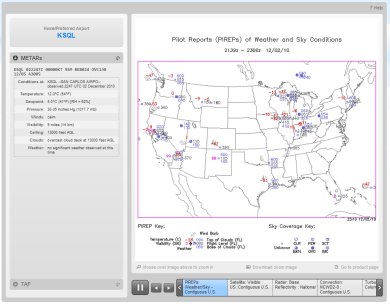|
The new weather.aero site is
a great example of government web design done right. Check it out! It's
an experimental version of the venerable aviation weather site ADDS, a joint production of
NWS, NSF, NOAA, and FAA. The new design is great: simple and clean, with
underlying web services to allow mashups with the data. What the kids
these days call "Web 2.0".
My favourite part of the design is how uncluttered it is. The home page contains the key products: a text METAR for home airport weather and a slideshow of weather map graphics showing national aviation conditions and forecasts. The slideshow UI is attractive with a tidy mouseover zoom. Drilling down a layer there's good, consistent page UI for different weather views like winds, radar images, and forecasts. There's nothing revolutionary about the UI but it's very cleanly executed and looks like 2010 instead of the previous 1998esque product. Usable simplicity achieved. In addition to the web page views there's a very interesting web service that lets you easily get XML or CSV data for weather observations, pilot reports, etc. This data has been available for integration before (for instance, via ftp) but this new web service is nicely centralized with thoughtful REST query options like "all METARs along this flight path".The site has modern community outreach, too. The team is on Twitter, Facebook, and has a Nabble-hosted forum. And it's not all faceless bureaucrats, you can even see and learn more about the developers. The US government produces all sorts of amazing software and data. But it's a culture apart from the Internet startup world and, to be honest, has often produced crappy websites. The new ADDS is a different thing entirely, a very nice bit of work. I'm excited to see a new generation of technology produced by government agencies.
Update: I misattributed who built the
experimental ADDS site. The site was built by
NCAR, with funding
and support from NWS, NSF, NOAA, and FAA. NCAR itself is not a
government agency, but rather an R&D center that receives a lot
of federal funding. It's
foundation story is
interesting, a 1960 solution to the same sort of culture gap
I mentioned above.
|
||

